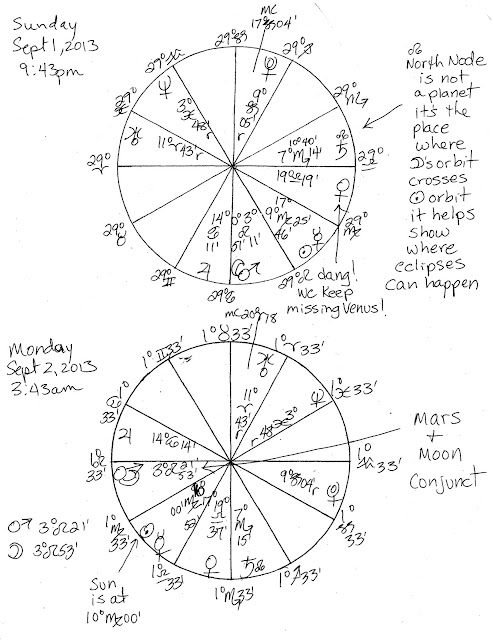 |
Venus near Saturn in upper left quadrant, and Moon near Jupiter in upper right quadrant. |
Saturday, September 28, 2013
Moon and Jupiter Radiate Light of Kindness on Buried Venus
Thursday, September 26, 2013
Using the UNL Sun's Motions Demonstrator to Understand the Zodiac
Jan 14, 2021 The links in this post have expired. The body of the post may have some helpful info but the UNL Astronomy site has had to adjust the delivery of their educational applets from Flash to Native Apps. But don't be discouraged, I'm getting ready to make new videos with the UNL's Native Apps and I have plenty of resources that I published since this post was made in 2013.
Here are links to the more recent pages and videos for understanding the mechanics behind the Zodiac:
Zodiac on Stellarium through One 24 Hour Cycle (5 minute Video)
Our Sky blog page about Medium Coeli or Midheaven
Our Sky blog page about Changing Amount of Daylight as Sun moves through Zodiac
The above links are all functional and worth checking out. The change of light from one day to next is quite variable, and it's that variability in change that the Zodiac mascots are chosen to illustrate.
Below is original post from 2013
UNL Sun’s MotionDemonstrator (the above embedded version is a bit fuzzy so I've included a link to the original interactive animation. Click on the blue text to open a new window at the UNL page.)
Sunday, September 22, 2013
Today's Change in the Mars Chain of Command
 |
| Sun is in upper left quadrant at 29 degrees Virgo 47 minutes. Chart for 11:32am Sept 22, 2013 |
Rulerships are a good way to gain a deeper understanding of planets and signs. It can seem silly to think of the Sun as being under the influence of little Mercury just because it is in the sign Virgo. One way to think of it, without having to learn a bunch about the geometry of the ecliptic, is to think of the signs as activities the planets pass through. Whenever any planet passes through a sign associated with basic communication, it is under the influence of the planet that communicates. The planets are the ‘doers’ and the signs are the various activities the ‘doers’ cycle through.
 |
| Sun is in upper right quadrant at 0 degrees Libra 02 minutes. Chart is for 5:32pm Sept 22, 2013. |
Monday, September 9, 2013
Moon conjunct Saturn Today
Monday, September 2, 2013
Moon Moves from Jupiter to Mars
Below is a series of 10 mini charts beginning with the one for Saturday afternoon when the Moon was conjunct Jupiter and they were in the 8th house. I labeled the houses in the big chart above, but not all of the mini series-- houses are always 1-12 beginning with the first pie slice under the eastern horizon (on the left side of the circle).
Watch how all the planets rotate through the houses 1 and 1/2 times clockwise, while the moon advances step by step from Jupiter to Mars in a counterclockwise direction.








